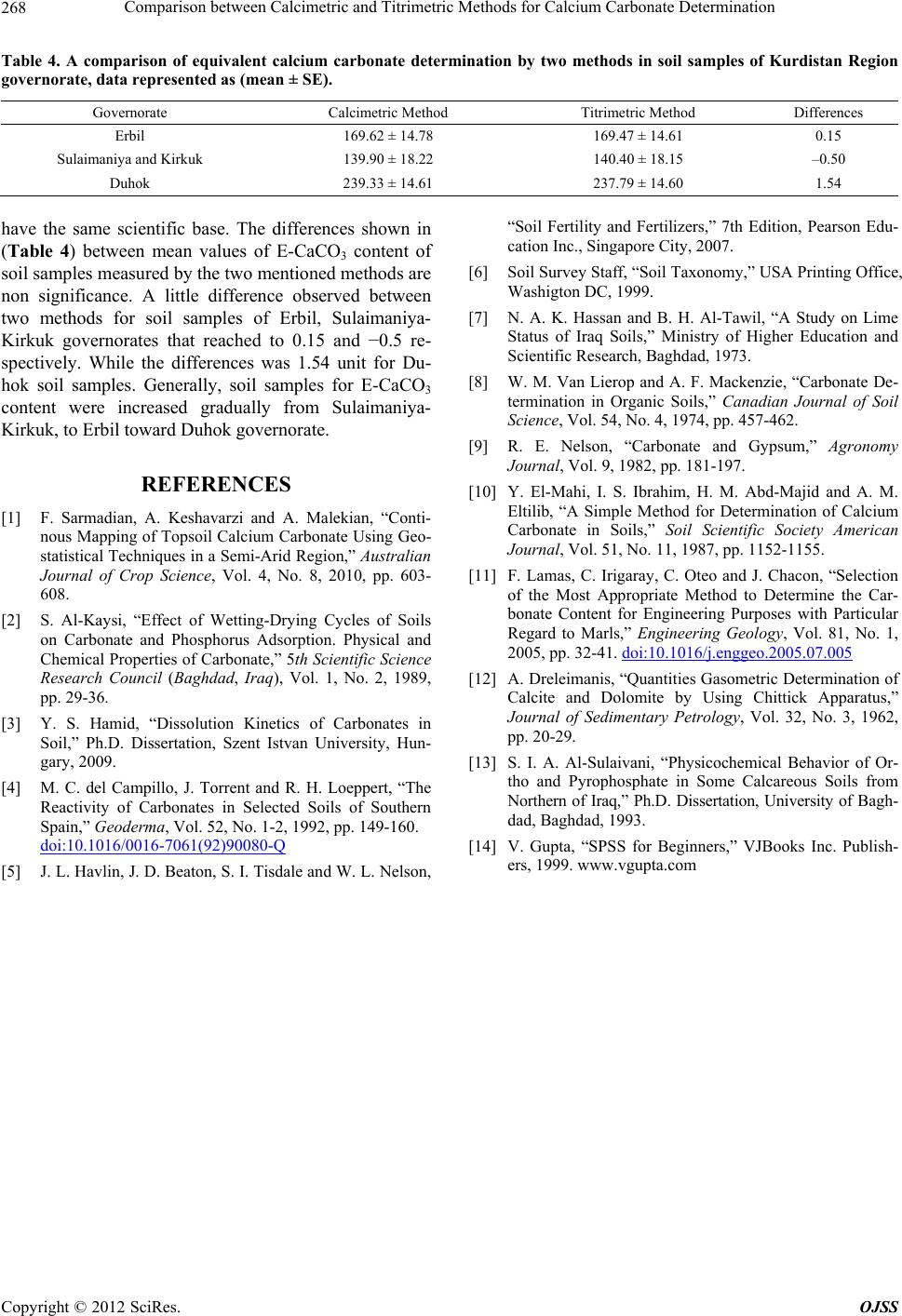
Comparison between Calcimetric and Titrimetric Methods for Calcium Carbonate Determination
Copyright © 2012 SciRes. OJSS
268
Table 4. A comparison of equivalent calcium carbonate determination by two methods in soil samples of Kurdistan Region
governorate, data represented as (mean ± SE).
Governorate Calcimetric Method Titrimetric Method Differences
Erbil 169.62 ± 14.78 169.47 ± 14.61 0.15
Sulaimaniya and Kirkuk 139.90 ± 18.22 140.40 ± 18.15 –0.50
Duhok 239.33 ± 14.61 237.79 ± 14.60 1.54
have the same scientific base. The differences shown in
(Table 4) between mean values of E-CaCO3 content of
soil samples measured by the two mentioned methods are
non significance. A little difference observed between
two methods for soil samples of Erbil, Sulaimaniya-
Kirkuk governorates that reached to 0.15 and −0.5 re-
spectively. While the differences was 1.54 unit for Du-
hok soil samples. Generally, soil samples for E-CaCO3
content were increased gradually from Sulaimaniya-
Kirkuk, to Erbil toward Duhok governorate.
REFERENCES
[1] F. Sarmadian, A. Keshavarzi and A. Malekian, “Conti-
nous Mapping of Topsoil Calcium Carbonate Using Geo-
statistical Techniques in a Semi-Arid Region,” Australian
Journal of Crop Science, Vol. 4, No. 8, 2010, pp. 603-
608.
[2] S. Al-Kaysi, “Effect of Wetting-Drying Cycles of Soils
on Carbonate and Phosphorus Adsorption. Physical and
Chemical Properties of Carbonate,” 5th Scientific Science
Research Council (Baghdad, Iraq), Vol. 1, No. 2, 1989,
pp. 29-36.
[3] Y. S. Hamid, “Dissolution Kinetics of Carbonates in
Soil,” Ph.D. Dissertation, Szent Istvan University, Hun-
gary, 2009.
[4] M. C. del Campillo, J. Torrent and R. H. Loeppert, “The
Reactivity of Carbonates in Selected Soils of Southern
Spain,” Geoderma, Vol. 52, No. 1-2, 1992, pp. 149-160.
doi:10.1016/0016-7061(92)90080-Q
[5] J. L. Havlin, J. D. Beaton, S. I. Tisdale and W. L. Nelson,
“Soil Fertility and Fertilizers,” 7th Edition, Pearson Edu-
cation Inc., Singapore City, 2007.
[6] Soil Survey Staff, “Soil Taxonomy,” USA Printing Office,
Washigton DC, 1999.
[7] N. A. K. Hassan and B. H. Al-Tawil, “A Study on Lime
Status of Iraq Soils,” Ministry of Higher Education and
Scientific Research, Baghdad, 1973.
[8] W. M. Van Lierop and A. F. Mackenzie, “Carbonate De-
termination in Organic Soils,” Canadian Journal of Soil
Science, Vol. 54, No. 4, 1974, pp. 457-462.
[9] R. E. Nelson, “Carbonate and Gypsum,” Agronomy
Journal, Vol. 9, 1982, pp. 181-197.
[10] Y. El-Mahi, I. S. Ibrahim, H. M. Abd-Majid and A. M.
Eltilib, “A Simple Method for Determination of Calcium
Carbonate in Soils,” Soil Scientific Society American
Journal, Vol. 51, No. 11, 1987, pp. 1152-1155.
[11] F. Lamas, C. Irigaray, C. Oteo and J. Chacon, “Selection
of the Most Appropriate Method to Determine the Car-
bonate Content for Engineering Purposes with Particular
Regard to Marls,” Engineering Geology, Vol. 81, No. 1,
2005, pp. 32-41. doi:10.1016/j.enggeo.2005.07.005
[12] A. Dreleimanis, “Quantities Gasometric Determination of
Calcite and Dolomite by Using Chittick Apparatus,”
Journal of Sedimentary Petrology, Vol. 32, No. 3, 1962,
pp. 20-29.
[13] S. I. A. Al-Sulaivani, “Physicochemical Behavior of Or-
tho and Pyrophosphate in Some Calcareous Soils from
Northern of Iraq,” Ph.D. Dissertation, University of Bagh-
dad, Baghdad, 1993.
[14] V. Gupta, “SPSS for Beginners,” VJBooks Inc. Publish-
ers, 1999. www.vgupta.com